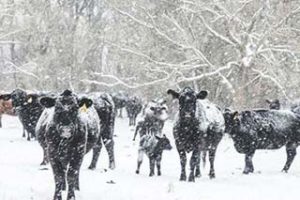
If you’re wintering cattle, here are 7 tips to keep them warm:
1. Focus on body condition score
The number one way to reduce cold stress in cattle is to improve body condition score.
Having a good body condition score going into winter does two things. First, a cow in body condition score 5 or 6 has a layer of fat insulation helping her conserve body heat. Second, cows in good body condition likely have a good diet, which can result in nice, warm winter hair coats.
2. Deliver more cattle feed
Make sure cows have enough feed and water. A cow’s feed intake will increase by 20 percent during cold weather. Before temperatures drop, increase the amount of feed delivered. Provide additional hay, or offer 20 percent more cattle feed in the bunk.
Increasing intake will increase the amount of fermentation in the rumen, and one of the biggest waste products of fermentation is heat. If you provide cows with more energy and get more forage into the rumen, more fermentation happens and more heat is produced. The process helps keep cows warm from the inside out.
3. Separate thin cows
Thin cows mixed with the rest of the herd probably won’t get the nutrition they need to maintain or gain body condition. Separate thinner cows – young or old – to help take off feeding pressure. Once separated, make sure cows have plenty of forage and access to cattle mineral and cattle supplements.
If you can’t separate thin cows, feed free-choice cattle supplements like a protein tub to give those cows access to feed at all times. Free-choice cattle supplements also provide a less competitive atmosphere than group-feeding protein cubes or hand-fed feeds.
4. Put up windbreaks
When wintering cattle, it’s important to remember that wind chill affects cattle just like it affects people. Keep cattle out of the wind if possible. You can put up a homemade windbreak, create one out of bales or install a permanent windbreak. Wooded areas also provide shelter from the wind.
When cows don’t have a windbreak, they feel the full effect of the wind, and it will cost you body condition. A drop in body condition score will result in additional feed cost to regain condition.
5. Provide cattle minerals and supplements
Cattle mineral is vital during cold weather because it impacts a cow’s metabolic process. If cows are short on mineral, their metabolism will slow down. Once metabolism slows, the cow isn’t producing as much heat, and she may start losing body condition score.
Providing cattle mineral and cattle supplements can also lead to better forage digestibility. A cow’s rumen microbes have mineral requirements and can also benefit from supplementation. Supplementing ramps up rumen microbes so they can digest more forage. The microbes can also get 25 or 30 percent more energy out of the forage they’re eating.
While wintering cattle, the environment tends to be muddy. Mud reduces the insulation factor of a cow’s hair coat, and a cow’s lower critical temperature goes up as a result. For instance, if a cow is clean and dry, she may be okay down to 5 degrees Fahrenheit. If a cow is dirty, her lower critical temperature may go up to 20 degrees Fahrenheit.Give cows plenty of space, and move hay rings and feeding stations to limit the creation of muddy areas. The cleaner cows stay, the better insulation their hair will provide.7. Break routine
We tend to feed cattle on a routine. We put out a set amount of cattle feed per day because we think that’s what the herd should need. But, pay close attention to temperature and watch cattle closely.
When you know it will be cold for the next few days, increase the feed offered at least 24 hours in advance to give cows a head start. Feeding cows after the storm is helpful, but the impact is greater when they are fed before.
